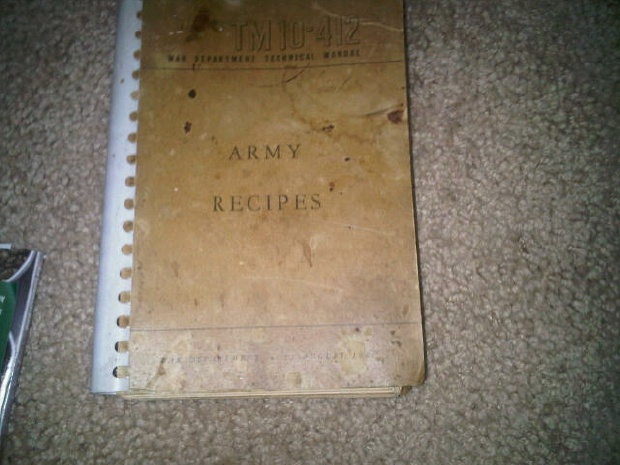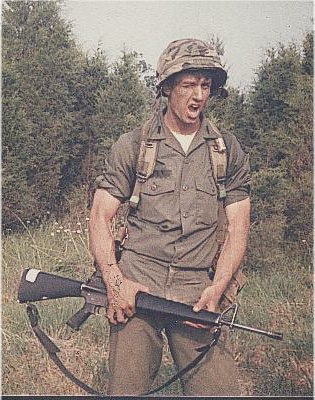I also have some things that are not my own family but are instead historical artifacts, like some heirlooms from Gen. Matthew Ridgway, who led the first U.S. Airborne Division, the 82nd Airborne, during the invasion of Normandy in 1944 and who later saved the UN in Korea by taking over the 8th Army and eventually replacing Gen. MacArthur as Supreme Commander for the Allied Powers. Then I have my own stuff, things like my Army Field Manuals, from my uneventful time in the military.
One neat Field Manual I have from World War 2 is "Army Recipes", because cooking was done by soldiers then(2) and it has parameters like 'Each recipe as set up will yield food sufficient for 100 portions of the size designated' - which made sense, since requisitions were done per 100 soldiers. So when I say cook for a whole army, I am not exaggerating.

It also has the regular handy equivalent measurements you might expect for feeding an army, quarts to a peck, etc. along with some practical ones for a soldier - like that a 'mess kit' cup is 1.5 liquid pints. What you might not expect is that it has some solid science in it also.
One example. For breakfast, here is what your army of 100 needs:
Coffee: Yield 7 gallons
Camp conditions:
Place 3 pounds of coffee in a 50 lb. coffee sack or large cloth bag to permit free circulation. Boil 7.5 gallons of water and reduce heat. Submerge the bag with a stick and push it up and down for circulation in the grounds, cover the kettle you must be using for 10-12 minutes, lift bag and drain. Serve at once.
Combat conditions:
As above, except you don't need the bag. Pour some cold water over the hot coffee because it will force the grounds to the bottom, it says.
Brilliant practical advice or old wives' tale? I set out to know.
Heating and cooling water is Newtonian physics and Einstein peeks his head in there as well. Water has some distinct expansion properties which make it special, maybe special enough to even push sediment to the bottom of a hot kettle. Your initial instinct will be the mass should be the same, since cooler water is taking up less space as particles are closer together and warming water takes up more space but there are still the same amount of particles, right? So cooler water is heaver. You are correct. And, you might add, if E=MC2, then your burner adds 1.11−17 kg of mass for every joule of heat added to the water, right? So warmer water is heavier? Correct again.
Here is how it works:
Water contracts in cold until about 4 degrees Celsius, when it starts to expand again - 0.9957 g/ml at 30 Celsius but .99998 g/ml at 4 degrees. And the actual mass added due to heat energy and E=MC2 is far too slight to notice, instead, it is the expansion properties of water that matter here.
This interesting expansion property is why oceans do not freeze from the bottom up - warmer water stays below the frozen, expanded, lower density ice - whereas if it continually contracted the way logic says it should, we would be dead. Water is the biggest science mystery around and it's a key part of why coffee is so delightful. So the army guys are correct that the cooler water does the trick, because coffee is in that perfect range where it works to settle the grounds.
Science accuracy: 100%
Nice work, army!
Where's the rest of the cooking you ask? What about the 150 egg omelette recipes and the 24 lbs. of meat bones for soup recipes and the 40 lb.s of potatoes for Au Gratin recipes?
My answer: It's the military. All they need is coffee and some bullets.
NOTES:
(1) She had not heard it since she was four years old, of course, because those records were not vinyl and could only be played a few times. I had it for years and one day decided for her birthday I would see what I could do. My search took me to the archive department at the Library of Congress and one of the archivists there was very interested because, obviously, not a lot of these survived - so he told me he would take a look.
The process he described later was rather elaborate but basically he used one of the more sensitive turntable stylus mechanisms in the world to try and play it and the result was a digital copy my mother got to hear, her father's voice as a young man nearly 60 years later.
(2) When I was just joining the Army, they were transitioning to two things; the solid green 'pickle suits' were on the way out, to be replaced by the camouflage BDUs you see today, and outside contractors were on the way in to do the cooking - unlike what the reputation of Army cooking used to be, the food during my military period was fantastic.

It was horrible watching real soldiers (this was basic training) walking around in cool BDUs while we were stuck in these pickle suits, which meant everyone knew we were nobodies. But 25 years and 25 lbs. later, they are nostalgic. Bonus: I still have my duffel bag and it looks like it was made yesterday. The Army makes pretty good stuff, for the most part.





Comments